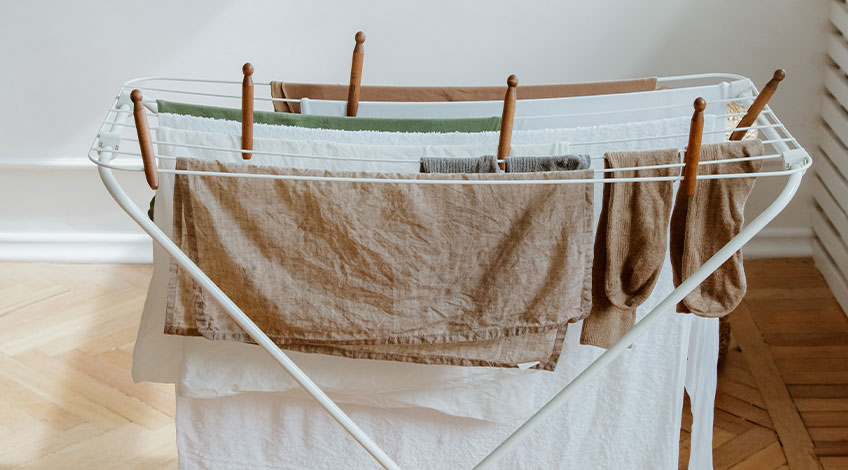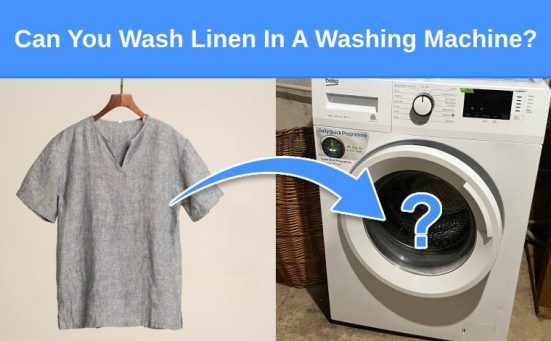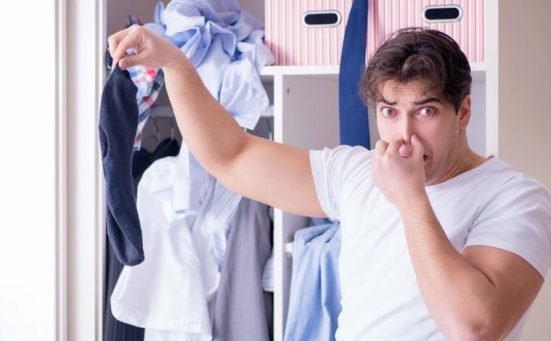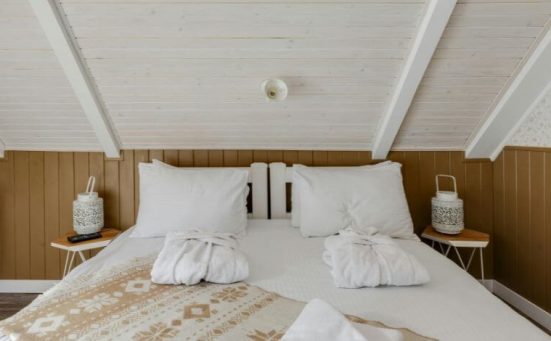
Heated Airer Vs Tumble Dryer: Which is really best?
It’s always best to dry your laundry outdoors on a clothesline because it always dries evenly and comes in smelling fresh as well as being clean. However, living in the UK outdoor drying isn’t always an option even in summer.
This means you’ll need to find an alternative way to get your laundry dry on cold, wet days. Which is where the debate about tumble dryers Vs heated airers comes in.
If you’re wondering which appliance is really the best option for your home, keep reading. Because in this article we look into both forms of drying clothes and compare everything from how much laundry you can dry at one time to running costs and much more in between.
What’s The Difference Between A Heated Airer And A Tumble Dryer?
Both heated airers and tumble dryers get laundry dry indoors, they both use electricity but they work in totally different ways. Tumble dryers dry clothes faster but that can cause some problems.
Heated airers take much longer to dry clothes but there’s much less chance of damaging them in the process. Then there’s the amount of space each appliance takes up.
Unless you have a spare room, a heated airer can take up a lot of living space. Whereas, once installed, the tumble dryer can easily be passed when walking through the room. Of course, the siting of both appliances is critical (more on this below) but at least you can pack a heated airer away when it’s not in use.
What Is A Heated Airer?

A heated airer looks exactly identical to a regular (non-heated) airer except it has an electric cable and mains plug attached. This is to heat up the element which is how the heat is passed around the airer to dry the laundry.
Heated airers are typically made from an aluminium frame with a number of bars that get heated by the electric element. The wet washing is hung on the bars or draped on the racks to dry.
The best heated airers are supplied with a cover that keeps all of the heat and moisture contained inside. This reduces drying times and helps to prevent too much moisture escaping which could lead to condensation and problems associated with damp.
What Are The Pros Of A Heated Airer?
The main advantages of a heated airer include;
- Heats Up Fast
The bars of a heated airer get hot really quickly which means the clothes are on their way to getting dry almost immediately. - Low Running Costs
Compared to a tumble dryer, a heated airer costs up to 50 or even 60% less to run than it does to run a tumble dryer. - Doesn’t Damage Clothes
The clothes are placed either on the bars or laid on the rack of a heated airer and they do not move, or get stretched, or ripped or bashed around in the drum like they could in a tumble dryer. This means using a heated airer prevents clothes from getting damaged either by mechanical action or overheating. - Lower Purchase Price
The price of heated airers ranges from around £40 for a basic model rising to around £200 for a top of the range model. Tumble dryers start at around £200 and rise to more than £1000. - Minimises The Need For Ironing
Because the laundry is hung from the bars of the heated airer, creases and wrinkles literally fall out as the garment dries. - Makes No Noise
Heated airers are silent when drying clothes. Unlike the noise made by a tumble dryer which includes motors, fans etc. - Can Be Placed Anywhere
Unlike a tumble dryer which has to be placed in a particular spot, a heated airer can be put in any position in any room. - Folds Flat When Not In Use
Once the laundry is dry, and you’re finished using the heated airer, it can be folded flat and stored away. Leaving more floor space in your home. - Come In Many Designs
There are many different shapes, sizes and styles of heated airers available. This gives you access to a wide range which means however much space you have, there will be a heated airer to fit. - More Environmentally Friendly
Heated airers use far less energy than tumble dryers which means that a heated airer has less impact on the environment. A Heated airer also has less components which also makes its environmental impact less as well. - Needs No Maintenance
There are no filters to clean, no pipes to check for blockages etc. Unlike a tumble dryer which has all of these and more.
What Are The Cons Of A Heated Airer?
The main disadvantages of a heated airer include;
- Takes Up Lots Of Space
Even the smallest heated airers take up quite a large amount of space when fully extended. This means there’s a good chance that you won’t be able to use the room the airer is set up in for anything else until the airer is packed away. - Fairly Labour Intensive
Unlike the tumble dryer where everything is just dumped into the drum, drying clothes on a heated airer is much more labour intensive. You will need to place each item onto the bars of the airer, one by one. They will also need turning during the drying process and as some will dry sooner than others, they will need removing before the rest. - Takes A Long Time To Get Clothes Dry
Although the cost of drying a full load of laundry on a heated airer is far cheaper, it will take up to 6 or 8 times longer to dry clothes on a heated airer compared to a tumble dryer. - Can Create Dampness In The Home
As the moisture evaporates from the clothes on the heated airer, the damp air has nowhere to go. It often condensates on the walls, windows and surfaces of your home. Which can cause all of the associated problems with dampness. These include; mould, mildew, rotting wood, peeling wallpaper etc.
What Is A Tumble Dryer?

Tumble dryers look like, and are the same size as washing machines. They work by forcing hot air around the wet clothes, as the heat causes the water to evaporate, the moist air is removed from the drum to allow the clothes to dry.
There are 3 types of tumble dryers which are;
- Vented Tumble Dryers
As the moisture is removed from a vented dryer it is vented through a hose to the outside of your home. This vent hose is either attached to a hole in the wall or draped out of a window. Vented dryers are the cheapest to buy but are also the least energy efficient and will cost more to run. - Condenser Tumble Dryers
The moisture removed from the laundry in a condenser tumble dryer is stored in a removable on board reservoir. This will need regular emptying. Condenser dryers are ideal for those who don’t have any space by an outside wall for a vent hose to be fitted. - Heat Pump Tumble Dryers
Heat pump dryers also collect water in an on board reservoir that will need to be emptied regularly. They also recycle the hot air created inside the drum to dry the laundry. These are the most energy efficient dryers and will save on energy bills. However, they have the longest running time of all types of dryers and they’re the most expensive to buy.
SEE ALSO: Different Types Of Tumble Dryers Explained
What Are The Pros Of A Tumble Dryer?
The main advantages of a tumble dryer over a heater airer include;
- Laundry Dries Faster
It is possible to get a full wash load dry in as little as 40 minutes using a tumble dryer. That same load could take as long as 6 to 8 hours on a heated airer. - Less Labour Intensive
All you need to do is put all of the clothes from the washer directly into the dryer. Then select the correct cycle and temperature and press the start button. When the dryer finishes, the clothes are dry. Unlike a heated airer where all of the clothes need to be individually placed on the bars and so on. - Clothes Feel Softer
Most of the time, clothes leave the tumble dryer feeling warm and soft to the touch. This is not always the case with clothes dried on a heated airer. - Can Dry A Full Wash Load At One Time
The average tumble dryer can dry a full wash load of laundry in one go. Many heated airers don’t have sufficient space to dry a full wash load. - Doesn’t Cause Damp
Tumble dryers remove moisture either by venting or condensation. This prevents that moisture forming as condensation in your home as it does when using a heated airer.
What Are The Cons Of A Tumble Dryer?
The main disadvantages of using a tumble dryer when compared to a heated airer include;
- Cost More To Run
Even the most energy efficient dryers cost far more to dry a wash load when compared to a heated airer. - Cost More To Buy
The cheapest tumble dryer costs around £200 whereas the cheapest heated airer is around £40. - Less Energy Efficient
As a tumble dryer uses around 50 to 60% more energy than a heated airer, tumble dryers are far less energy efficient. - Not So Environmentally Friendly
That extra energy consumption has a greater impact on the environment. - Noisy When Running
When running, the average tumble dryer is loud enough to drown out normal conversation. Heated airers, on the other hand, are silent. - Can Cause Static Electricity
As the drum spins the items of laundry rub together as they tumble around. This can cause a static charge to build up in the clothes. This is most likely to affect clothes made from synthetic fabrics. - Can Create Creases
The heat produced in a tumble dryer should help remove wrinkles and creases. However as the clothes get twisted and tangled in the drum it can lead to them becoming creased. - More Likely To Damage Clothes
The rough and tumble action of the turning drum coupled with the sometimes intense heat that clothes are subjected to in a dryer can cause damage. Clothes can stretch, shrink, rip, tear or fray. - Take Up Permanent Space
Tumble dryers are large appliances and once they are placed in position, they’re not often moved. Heated airers can be packed away when finished with, not so tumble dryers. - Need Regular Maintenance
Every time you use a tumble dryer your clothes will shed some fabric. This collects in the lint filter of your appliance and will need to be emptied regularly. If you have a condenser or heat pump dryer, the water reservoir will need to be emptied regularly too. - Clothes Don’t Always Dry All Over
Many tumble dryers have sensors which detect when the laundry is dry and cuts the power, shutting the machine down. Sometimes, it’s only the clothes on the top of the bundle that are actually dry. The damp clothes in the middle of the bundle are covered by the dry clothes.
Which Is Better Tumble Dryer Or Heated Airer?

The truth is, you’re the only one that can answer this question. It all depends on a number of factors including;
- Your Budget
Tumble dryers cost more to buy and more to run than heated airers. - The Amount Of Space You Have
You realistically need an unused room to set up a heated airer as they take up a lot of space. Tumble dryers once set up become like part of the fixtures and fittings of your home. Over time you almost forget they’re there (until laundry day). - How You Feel About Environmental Issues
Tumble dryers have a greater environmental impact than heated airers and if this is important to you, it’s something to consider. It’s not just energy usage either, all of the various component parts in a tumble dryer need sourcing too. - How Much Time You Have
Even the biggest heated airer which can take a large capacity of laundry at one time, will still take anywhere between 3 to 8 hours to dry. In that time you could potentially have dried 2 to 4 full wash loads in a tumble dryer. - Your Family Living Arrangements
If you have a large family or young children, you might need the convenience offered by a tumble dryer. Plus if you live in a small flat, you might not have the floor space for a heated airer even if it is only for one day per week. If you live alone, a heated airer could be the ideal drying solution, but if you have a young family and you live in a small flat, a heated airer could be the recipe for disaster.
Tumble Dryer Vs Heated Airer Price Comparison
Heated Airer Price
The price of a heated airer starts at around £40 for a basic model and rises to around £200 for a top of the range model.
Running Costs
Based on current UK prices of 34p per unit, a basic two tier heated airer costs around 7 to 8p per hour to run. This works out at around 65p for an 8 hour drying session.
Three tiered models will cost around 11 to 12p per hour. Which works out at around 90p to £1.00 per 8 hours.
Tumble Dryer Price
Tumble dryers cost far more to buy with the cheapest, vented dryers costing around £200 to £300. Condenser dryers cost around £250 to £450 and heat pump dryers cost around £350 to £700.
These prices are correct at date of publication but are subject to regional variation
Running Costs
Heat pump dryers are the cheapest tumble dryers to run with an average running cost of around 75p. Followed by condenser dryers costing around £1.90 per load and vented dryers costing an average of around £2.00 per load.
Should I Buy A Tumble Dryer Or A Heated Airer?
Whether you should buy a tumble dryer or a heated airer depends on many factors. If you have a large family and you need clothes dry in a hurry, a tumble dryer is going to be your best choice. Also if you don’t have much floor space a tumble dryer stacked on top of your washing machine might be your best option.
On the other hand, if you have a small budget and a limited income, a heated airer will cost less to purchase and considerably less to use as well. Then there’s the environmental impact, heated airers are far better for the environment than even the most energy efficient tumble dryer.
What Did You Decide?
After weighing up the pros and cons of both tumble dryers and heated airers we hope this article has been useful in helping you to make an informed decision.
Please let us know in the comments which appliance you decided on and why.
SEE ALSO:
Frequently Asked Questions
It works out far cheaper to run a heated airer compared to a tumble dryer. Heated airers will cost around 65p to £1.00 to dry a full wash load. Whereas a tumble dryer will cost anywhere between 75p to £2.00 (depending on the type of dryer) to dry the same load.
Heated airers don’t cause damp, but the clothes drying on them can. As the clothes dry, water evaporates into the surrounding air. This moisture laden air will condense on the first cool surface it touches. This can lead to damp and all of its associated problems.
Compared to tumble dryers, heated airers are way more energy efficient. Even though a heated airer can take as long as 6 to 8 hours to dry clothes it will still use less electricity than a tumble dryer that only takes 40 to 50 minutes.




